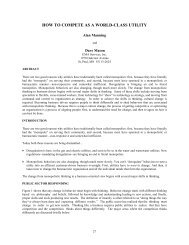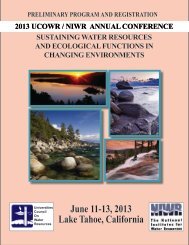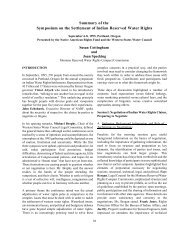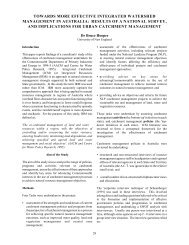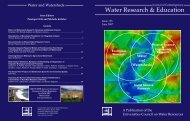Full Journal of Contemporary Water Research and Education, Issue ...
Full Journal of Contemporary Water Research and Education, Issue ...
Full Journal of Contemporary Water Research and Education, Issue ...
You also want an ePaper? Increase the reach of your titles
YUMPU automatically turns print PDFs into web optimized ePapers that Google loves.
Implementation <strong>of</strong> Australian <strong>Water</strong> Laws117national water protocols. The reforms <strong>of</strong> 1994have thus created much change <strong>and</strong> resulted inthe restructuring <strong>of</strong> water management in eachstate. The reforms insisted that each state ensurethat future water projects were based on ESDprinciples in conjunction with much more privatesector participation <strong>and</strong> community involvementin water planning at a regional level.Despite these initiatives, in 2000 the National<strong>Water</strong> Audit assessed that one-quarter <strong>of</strong> thesurface water management areas <strong>and</strong> over onethird<strong>of</strong> the ground water management areas wereat a high level <strong>of</strong> development <strong>and</strong> approaching orbeyond sustainable extraction limits (Australian<strong>Water</strong> Resources Assessment 2000, Evans 2001,<strong>and</strong> Jones et al. 2001). This assessment <strong>of</strong> theregional pattern <strong>of</strong> water development is basedon a broad definition <strong>of</strong> “sustainable flow/yield.”The definition adopted by the Audit is based notjust on physical aspects but also on economic,social, <strong>and</strong> environmental considerations includingwater quality <strong>and</strong> salinity. Paradigm 3 is hencecharacterized by introspective institutional reformin each state <strong>and</strong> the imposition <strong>of</strong> specific policiessuch as water markets in the context <strong>of</strong> ESD.Paradigm 4 dated from June 2004 with theinitiation <strong>of</strong> the National <strong>Water</strong> Initiative <strong>and</strong>extends <strong>and</strong> develops Paradigm 3’s objectives.Paradigm 4 is characterized by the 80 nationalprotocols on water planning processes <strong>and</strong> regionalwater planning documents as a key to achieveintegration <strong>and</strong> ESD. The Australian Governmentacknowledges that efficient <strong>and</strong> more productivewater use will become increasingly important overthe coming decades as water issues impact uponthe continued stability <strong>of</strong> Australia’s rural sector,urban communities <strong>and</strong> the nation’s economicwell-being. The Government is determined tocontinue increasing efficiency in water use <strong>and</strong>implementing reforms to achieve this nationalobjective (Department <strong>of</strong> Agriculture, Fisheries<strong>and</strong> Forestry 2006). Paradigm 3 <strong>and</strong> 4 are thefocus <strong>of</strong> this paper <strong>and</strong> are detailed below.This paper examines the perceptions, knowledge,<strong>and</strong> underst<strong>and</strong>ings <strong>of</strong> ESD by key front linepeople in the water community, namely the CEOs<strong>of</strong> 183 water supply businesses. The method wasto identify the relevant policies <strong>and</strong> laws from state<strong>and</strong> federal instruments <strong>and</strong> from these identify thebehavioral changes required. The next step wasto design an instrument to evaluate (on an elevenpoint Likert scale) perceptions, underst<strong>and</strong>ings,<strong>and</strong> attitudes to the policies <strong>and</strong> laws by the keyactors. The responses can then be used to evaluatethe efficacy <strong>of</strong> the policies <strong>and</strong> laws <strong>and</strong> suggestreform proposals or different approaches to achievethe aims. Sometimes an approach is identifiedbecause respondents in different age groupsrespond differently (Hurlimann <strong>and</strong> McKay 2003).This approach is part <strong>of</strong> the general evidencebasedpolicy movement, but consists <strong>of</strong> bottom-upsubsets called Evaluation by policy implementers<strong>and</strong> Evaluation <strong>of</strong> law by implementers.Increasing Fiscal Federalism to Drive ESDin Australian <strong>Water</strong> Laws <strong>and</strong> Policiessince 1994The 1994 reforms required a number <strong>of</strong>outcomes:••••••Markets for water entitlements to improveefficiency<strong>Full</strong> cost recoveryTwo-part water tariffs (adopted in urban areasin 1998 <strong>and</strong> rural areas in 2001)Separate identification <strong>and</strong> funding <strong>of</strong>community-service obligationsAllocation <strong>of</strong> water for environmental <strong>and</strong>social needsPrinciple <strong>of</strong> subsidiarity, i.e. management <strong>of</strong>resources at level closest to user.This Paradigm was prompted by internationalmovements toward corporatization <strong>of</strong> waterauthorities known as competition reforms (Saleth<strong>and</strong> Dinar 2004), by the 1990 EcologicallySustainable Development process for ninespecific industry sectors, driven in part by the UNCommission on Environment <strong>and</strong> Development(the Brundtl<strong>and</strong> Commission) (Brundtl<strong>and</strong> 1987),<strong>and</strong> by community reactions to large dams <strong>and</strong>environmental degradation <strong>of</strong> l<strong>and</strong> <strong>and</strong> water, suchas the Mabo decision in 1990 (Mabo v State <strong>of</strong>Queensl<strong>and</strong>) which rebutted Terra Nullius. Thereis a much broader discussion <strong>of</strong> this in McKay2002 a <strong>and</strong> b <strong>and</strong> 2005. The 1994 goals provided astarting point for reform.This paper deals with the perceptions <strong>of</strong> theCEOs in 2005/6, hence it covers Paradigms 3 <strong>and</strong>JOURNAL OF CONTEMPORARY WATER RESEARCH & EDUCATIONUCOWR



